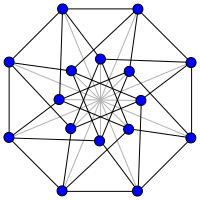Folded cube graph
| Folded cube graph | |
|---|---|

The order-5 folded cube graph (i.e, the Clebsch graph).
|
|
| Vertices | 2n−1 |
| Edges | 2n−2n |
| Diameter | floor(n/2) |
| Chromatic number | 2 (for even n), or 4 (when odd). |
| Properties |
Regular graph Hamiltonian Distance-transitive. |
In graph theory, a folded cube graph is an undirected graph formed from a hypercube graph by adding to it a perfect matching that connects opposite pairs of hypercube vertices.
The folded cube graph of order k (containing 2k − 1 vertices) may be formed by adding edges between opposite pairs of vertices in a hypercube graph of order k − 1. (In a hypercube with 2n vertices, a pair of vertices are opposite if the shortest path between them has length n.) It can, equivalently, be formed from a hypercube graph (also) of order k, which has twice as many vertices, by identifying together (or contracting) every opposite pair of vertices.
An order-k folded cube graph is k-regular with 2k − 1 vertices and 2k − 2k edges.
The chromatic number of the order-k folded cube graph is two when k is even (that is, in this case, the graph is bipartite) and four when k is odd. The odd girth of a folded cube of odd order is k, so for odd k greater than three the folded cube graphs provide a class of triangle-free graphs with chromatic number four and arbitrarily large odd girth. As a distance-regular graph with odd girth k and diameter (k − 1)/2, the folded cubes of odd order are examples of generalized odd graphs.
When k is odd, the bipartite double cover of the order-k folded cube is the order-k cube from which it was formed. However, when k is even, the order-k cube is a double cover but not the bipartite double cover. In this case, the folded cube is itself already bipartite. Folded cube graphs inherit from their hypercube subgraphs the property of having a Hamiltonian cycle, and from the hypercubes that double cover them the property of being a distance-transitive graph.
...
Wikipedia
